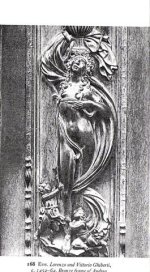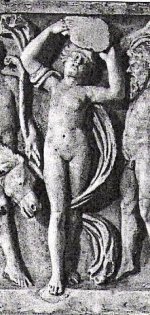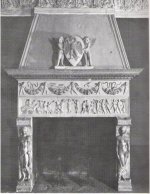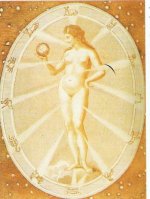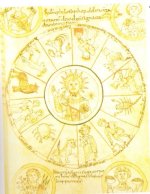'Coronation of the Virgin' from the 'Book of the Holy Trinity (1415] by the Alchemist Ulmannus.
In Ulmannus system Mary is crowned by the divine trinity as the divine matrix or anima mundi from which all being springs. Mary [representing the body - moon] sits between the Father [representing the soul and attributed to the Sun] and the Son [representing spirit - Mercury] and above her the dove of the holy spirit, she represents the body [Moon]. In the four corners are the four holy beasts representing [according to the accompanying text in 'Alchemy and Mysticism' by Alexander Roob, p.478]:
Bull, Luke, Fire, Mars
Angel, Mathew, water, Venus
Eagle, John, earth, Saturn
Lion, Mark, air, Jupiter
These [trinity and quartenary] correspond to the seven metals, seven virtues, colours, days of the week and hours of the day. Below is the 'mirror of the holy trinity', a shield with the double headed black eagle dedicated to Emperor Frederick and also as symbol of St. John as patron saint of alchemy. Boehme uses the image of the 'mirror of the trinity' in reference to Sophia: "she is 'the exhaled force' or 'what is found in Nothing, in which father, son and spirit are seen". [Von der Gnadenwahl, 1623].
In reference to alchemy the symbols star, moon and sun are also significant. Here is a picture of StarMoonSun from a woodcut from Rosarium philosophorum [c.1550] illustrating an alchemical poem 'Sol and Luna' [written c.1400].
The Coronation of the Virgin and the Star.Sun.Moon are further connected in that it appears to me the central image of the coronation of the virgin is perhaps the model for the penultimate illustration in the 'rosarium philosphorum'[from which the star,moon sun image also comes] which shows the being of the alchemist or nature being crowned by the father,son and holy spirit [rather than mary]. In between these are illustrated the process of death and resurrection. Full text [english translation] with illustrations can be found at the excellent alchemical website:
The coloured drawing from Ulmanus [c.1415] is also the model for a woodcut print as Emblem 14 in Pandora: quote "This series of 18 woodcuts was first printed in Hieronymus Reusner, Pandora, Basel 1582 (reprinted in 1588). This was later printed with engraved versions of the woodcuts as Johann Michael Faust, Compendium alchymist, novum, sive Pandora explicata... Frankfurt, 1706. This series of emblems is based on one of the earliest German alchemical manuscripts Der buch der heiligen Dreifaltigkeit. There are 15 manuscripts known of this work the first copies of which have been dated to 1415-16. Many of these manuscripts have a series of coloured drawings on which the printed emblems were based."
quote text to Emblem 14 from pandora:
"Imbibition of the body. Above a shield, which bears the picture of a crowned woman supporting Christ crucified as a double-headed eagle (as in the previous emblem), a Christ figure holding an orb labelled 'corpus', places a crown on the head of a woman, labelled
'anima'. Beside them an old man or Father figure, labelled 'sapientia' watches. From above the winged dove of the Holy Spirit descends, bearing the label 'terra'. At the four corners stand the winged symbols of the Evangelists, The eagle of John, the lion of Mark, the bull of Luke and the man or angel of Matthew." End quote [text from the alchemical website here:
http://www.alchemywebsite.com/s_pandor.html]
So it appears the central female figure of `Mary' is also interpreted as `anima', giving us an example of a figure of `anima' together with the `four holy beasts'.
Of the double headed black eagle: "Turning to particular examples, some of the earliest seem to be the figures from Buch der Heiligen Dreifaltigkeit (circa 1400) and its later version Hieronymus Reusner's Pandora (1588), which use both heraldicized images and actual coats-of-arms. The main motif is the black double-headed eagle intended to denote the Philosopher's Stone, and some of the more complex heraldic devices incorporating that symbol represent the whole process of the Magnum Opus. The double headed eagle divided vertically ("per pale" in heraldic language) and with each half of a different colour is also present in De alchimia (16th c.) attributed to St. Thomas Aquinas as well as in some earlier alchemical treatises." Quote from:
http://www.levity.com/alchemy/hermhera.html
The later engraved copies show it was an ongoing image or model used in alchemy, the later engraved copies have some more details, such as the inscription identifying the central female figure as anima. The alchemical imagery is of course based upon traditional trinitarian iconography, but replacing the 'globe' of the world with the anima. For example from the book of hours of the duc de berry, 1380, which also includes the four holy beasts:
The replacement with anima mundi reflects a platonic influence through John Scotus and the school of chartre Peter Abelarde, William of Conches. It was also an influence upon the feminine theology of Hildegard. Concious though that it been declared in 'error' by the cistercians [Bernard of Clairvaux, 'De erroribus Abaelardi] she avoids the use of the anima mundi directly, replacing it with the figure of 'Caritas', though it is obvious from the speech of Caritas that she is none other than 'anima mundi', comparable to the Shekinah of jewish mysticism, the spirit of wisdom that 'fills the whole earth', the goddess Natura of medieval poetry [Newman]. As 'anima mundi' crowned within the almond laurel wreath she is the world [cosmos, universe] as a mirror of the trinity, the sensible world as a book in which one may 'read' the attributes and power of G-d in his trinitarian unity [the world, the year, the soul/body, each with their own 'trinitarian' sublayer, ie past, present, future; breadth, width, depth; life, work and reason], a trinitarian image often composed together with symbols of the quarternary, paralleling the ubiquitous image of the 'table of temperaments' from Isadore of Seville's 'De Natura Rerum'. If we are right to see in the female figure of the TdM an image of the anima mundi I think we are also right to note that after such an intepretation was declared 'in error' by the cistercian such imagery was not used, or at least was very rare, in any orthodox source, and in fact after the 13th century is only to be found commonly in alchemical texts wherein the astrological and alchemical symbolism of the four holy beasts are prevalent. I think we are justified therefore in considering the full multivalent symbolism of the four beasts and not just restrict them, as has been suggested, as symbols of the four evangelists 'only'. We may also note that eschatological symbolism and alchemical allegory are connected in 'spiritual' alchemy, each narrating in their own way a 'spiritual rebirth' or path of salvation, and that in alchemy 'new jerusalem' itself is taken as a symbol of the final outcome itself, the philisophers stone and spiritual rebirth, the 'crowning of the magi'.
The Anima Mundi was also identified as the Holy Spirit and as such we may find some comparison with the Tower card through Hildegards 'Tower of the Church' in the 'Tower'. Her 'Tower' represents 'ecclessia sustained by the holy spirit, which kindles fiery virtues. Some of her children remain faithful, while others attack her.' The image is from 'Scivias II.4' and reproduced in Barbara Newman's 'Sister of Wisdom' p.217. The great 'fire' like flames of the tower represent the great light of the holy spirit, which the tower represents.
The image of tower with title 'house of god' may imply in the TdM the 'tower' is to be identified with the 'church', which is at variance with the Turris Ecclesia of St. Hildegard in that the Turris [tower] and Ecclessia [Church] though connected are seperate and cannot be taken, for reasons of dogma, as interchangeable with each other. The tower and the church [represented by the allegorical female figure of Ecclesia] in St. Hildegarde do not 'both' represent the church, rather they represent the relationship between the 'holy spirit' [the phallic tower] and the Church as Bride [ecclessia]. In the TdM however the tower is identified as the 'house of god', which possibly reflects the unorthodox and platonic influenced schools which sought to identify the holy spirit with the anima mundi, the tower as a symbol of the cosmos in which the holy spirit of god dwells. The identification of the holy spirit with the anima mundi was part of the neo-platonic influence of the 13th century inspired by the spread of the works of John Scotus which was rejected as unorthodox by the church fully aware of the inherent pantheistic implications. Despites its rejection by the orthodox church the concept remained within sub-cultural sidehoots such as alchemy and culminating in and expounded upon within the Christian platonic schools of the 15th century Italian renaissance.
Kwaw

